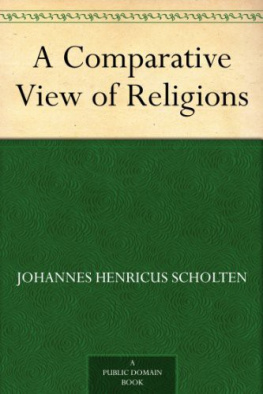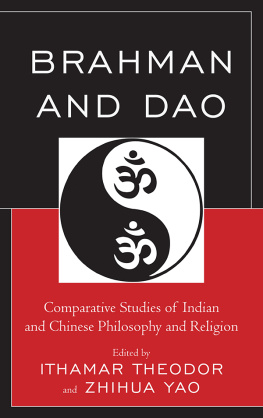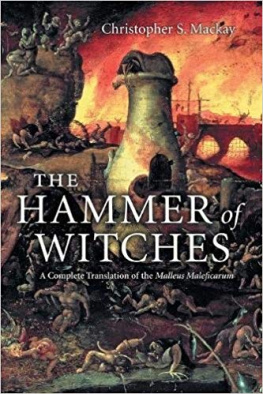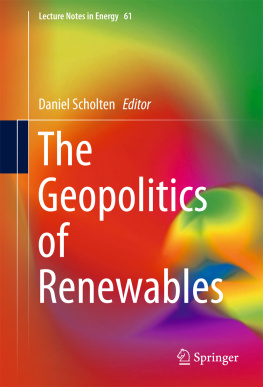Johannes Henricus Scholten - A Comparative View of Religions by Scholten
Here you can read online Johannes Henricus Scholten - A Comparative View of Religions by Scholten full text of the book (entire story) in english for free. Download pdf and epub, get meaning, cover and reviews about this ebook. year: 2009, publisher: Intl Business Pubns USA, genre: Religion. Description of the work, (preface) as well as reviews are available. Best literature library LitArk.com created for fans of good reading and offers a wide selection of genres:
Romance novel
Science fiction
Adventure
Detective
Science
History
Home and family
Prose
Art
Politics
Computer
Non-fiction
Religion
Business
Children
Humor
Choose a favorite category and find really read worthwhile books. Enjoy immersion in the world of imagination, feel the emotions of the characters or learn something new for yourself, make an fascinating discovery.
- Book:A Comparative View of Religions by Scholten
- Author:
- Publisher:Intl Business Pubns USA
- Genre:
- Year:2009
- Rating:4 / 5
- Favourites:Add to favourites
- Your mark:
- 80
- 1
- 2
- 3
- 4
- 5
A Comparative View of Religions by Scholten: summary, description and annotation
We offer to read an annotation, description, summary or preface (depends on what the author of the book "A Comparative View of Religions by Scholten" wrote himself). If you haven't found the necessary information about the book — write in the comments, we will try to find it.
A Comparative View of Religions by Scholten — read online for free the complete book (whole text) full work
Below is the text of the book, divided by pages. System saving the place of the last page read, allows you to conveniently read the book "A Comparative View of Religions by Scholten" online for free, without having to search again every time where you left off. Put a bookmark, and you can go to the page where you finished reading at any time.
Font size:
Interval:
Bookmark:
This eBook is for the use of anyone anywhere at no cost and with
almost no restrictions whatsoever. You may copy it, give it away or
re-use it under the terms of the Project Gutenberg License included
with this eBook or online at www.gutenberg.org
Title: A Comparative View of Religions
Author: Johannes Henricus Scholten
Release Date: December 19, 2006 [eBook #20137]
Language: English
Character set encoding: ISO-8859-1
***START OF THE PROJECT GUTENBERG EBOOK A COMPARATIVE VIEW OF RELIGIONS***
and the Project Gutenberg Online Distributed Proofreading Team
(http://www.pgdp.net/)
from page images generously made available by the
Making of America collection of the University of Michigan Libraries
(http://www.hti.umich.edu/m/moagrp/)
| Note: | Images of the original pages are available through the Making of America collection of the University of Michigan Libraries. See http://www.hti.umich.edu/cgi/t/text/text-idx?c=moa;idno=AJF2939.0001.001 |
COMPARATIVE
VIEW OF RELIGIONS.
Translated from the Dutch of J. H. Scholten,
PROFESSOR AT LEYDEN,
BY FRANCIS T. WASHBURN.
Reprinted by permission from "The Religious Magazine and Monthly Review."
BOSTON:
CROSBY & DAMRELL, 100 WASHINGTON ST.
1870.
COMPARATIVE
VIEW OF RELIGIONS.
The conception of religion presupposes, a, God as object; b, man as subject; c, the mutual relation existing between them. According to the various stages of development which men have reached, religious belief manifests itself either in the form of a passive feeling of dependence, where the subject, not yet conscious of his independence, feels himself wholly overmastered by the deity, or the object of worship, as by a power outside of and opposed to himself; or, when the feeling of independence has awakened, in a one-sided elevation of the human, whereby man in worshiping a deity deifies himself. In the highest stage of religious development, the most entire feeling of dependence is united in religion with the strongest consciousness of personal independence. The first of these forms is exhibited in the fetich and nature-worship of the ancient nations; the second in Buddhism, and in the deification of the human, which reaches its full height among the Greeks. The true religion, prepared in Israel, is the Christian, in which man, grown conscious of his oneness with God, is ruled by the divine as an inner power of life, and acts spontaneously and freely while in the fullest dependence upon God. Since Christ, no more perfect religion has appeared. What is true and good in Islamism was borrowed from Israel and Christianity.
Although it is probable that every nation passed through different forms of religious belief before its religion reached its highest development, yet the earlier periods lie in great part beyond the reach of historical investigation. The history of religion, therefore, has for its task the review of the various forms of religion with which we are historically acquainted, in the order of psychological development.
FETICHISM. THE CHINESE. THE EGYPTIANS.
1. FETICHISM.
The lowest stage of religious development is fetichism, as it is found among the savage tribes of the polar regions, and in Africa, America, and Australia. In this stage, man's needs are as yet very limited and exclusively confined to the material world. Still too little developed intellectually to worship the divine in nature and her powers, he thinks he sees the divinity which he seeks in every unknown object which strikes his senses, or which his imagination calls up. In this stage, religion has no higher character than that of caprice and of love of the mysterious and marvelous, mixed with fear and a slavish adoration of the divine. The worship and the priest's office (Shaman, Shamanism) consist here chiefly in the use of charms, to exorcise a dreaded power. From this savage fetichism the nature-worship found among the Aztecs in Mexico, and the worship of the sun in Peru, are distinguished by the greater definiteness and order of their religious conceptions and usages. In them the gods have names, and an ordained priesthood cares for the religious interests of the people. The highest form to which fetichism has attained is the worship of Manitou, the great spirit, which is found among the ancient tribes of North America.
2. THE CHINESE.
When man reaches a higher development, caprice and chance disappear from religion. Having outgrown fetichism, man begins, as is the case among the Chinese, to distinguish in the world around him an active and a passive principle, force and matter (Yang and Yn), heaven and earth (Kien and Kouen). We have here nature-worship in its beginnings. In this stage, even less than in fetichism, is there a definite idea of God, much less a conception of him as personal and spiritual lord. The Chinese, from the practical, empirical point of view peculiar to him, recognizes the spiritual only in man and chiefly in the state. His religion, therefore, is confined exclusively to the faithful keeping of the laws of the state (the Celestial Kingdom), in which he sees the reflection of heaven, to the recognition of the Emperor as the son and representative of heaven, and to the worship of the forefathers, especially of the great men and departed emperors, to whose memory the Chinese temples, or pagodas, are dedicated. The origin of this religion dates, according to the tradition, from Fo-hi (2950 B.C.), the founder of the Chinese state. In the fifth century before Christ, Kong-tse, or Kong-fu-tse (Confucius), appeared as a reformer of the religion of his countrymen, and gathered the ancient records and traditions of his people into a sacred literature, which is known by the name of the "King" (the books), "Yo-King" (the book of nature), "Chu-King" (the book of history), "Chi-King" (the book of songs). The contents of the "King" became later with the Chinese sages Meng-tse (360 B.C.) and Tschu-tsche (1200 A.D.) an object of philosophical speculation. The doctrine of Lao-tse, the younger contemporary of Kong-tse, which lays down as the basis of the world, that is of the unreal or non-existent, a supreme principle, Tao, or Being, corresponds with the Brahma doctrine of the Indians, among whom he lived for a long time; but this doctrine never became popular in China.
3. THE EGYPTIANS.
The worship of nature, which is seen in its beginnings among the Chinese, exhibits itself among the Egyptians in a more developed form as theogony. Here also the reflecting mind rose to the recognition of two fundamental principles, the producing and the passive power of nature, Kneph and Neith, from which sprang successively the remaining powers of nature, time, air, earth, light and darkness, personified by the fantasy of the people into as many divinities. The Egyptian mythology also (none has as yet been discovered among the Chinese) exhibits a like character. Fruitfulness and drought, the results of the Nile's overflowing and receding, are imaged in the myth of Osiris, Isis, and Typhon. The visible form under which the divine was worshiped in Egypt was the sacred animal, the bull Apis, dedicated to Osiris, the cow, dedicated to Isis, as symbols of agriculture; the bird Ibis, the crocodile, the dog Anubis, and other animals, whose physical characteristics impressed the as yet childish man, who saw in them the symbol, either of the beneficent power of nature which moved him to thankfulness, or of a destructive power which he dreaded and whose anger he sought to avert. The religion of Egypt was not of a purely spiritual character. To the man whose eye is not yet open to the manifestation of the spiritual around him and in him, the divine is not spirit, but as yet only nature. The animal, although in the form of the sphinx approaching the human, holds in Egyptian art a place above the human as symbol of the divine.
Font size:
Interval:
Bookmark:
Similar books «A Comparative View of Religions by Scholten»
Look at similar books to A Comparative View of Religions by Scholten. We have selected literature similar in name and meaning in the hope of providing readers with more options to find new, interesting, not yet read works.
Discussion, reviews of the book A Comparative View of Religions by Scholten and just readers' own opinions. Leave your comments, write what you think about the work, its meaning or the main characters. Specify what exactly you liked and what you didn't like, and why you think so.








